Year-Round Comfort
Metal is a material that is designed to withstand any type of weather. It does not matter what region you are in, it can handle diverse climates. Unfortunately, humans are not capable of the same, that is why if you have a structure made of metal, you need to make sure it is insulated for your comfort all year round.
Take the case of a metal barn,
A metal barn is a durable and cost-effective structure for agricultural, commercial, or personal use. However, one of its biggest challenges is temperature regulation. Metal buildings conduct heat in the summer and lose warmth quickly in the winter, making them uncomfortable if they are not properly insulated.
Insulating your metal barn can help regulate indoor temperatures, reduce energy costs, and protect livestock, equipment, and stored goods from extreme weather conditions. Understanding the best insulation methods, materials, and installation techniques is crucial for achieving year-round comfort in your metal barn.
Understanding the Importance of Insulation
Insulation is essential for metal barns because metal is a highly conductive material. Without insulation, heat transfers easily, causing the interior of the barn to become unbearably hot in the summer and freezing in the winter. Insulation acts as a barrier to slow heat transfer, maintaining a more stable indoor environment. This not only makes the barn more comfortable for animals, workers, or stored equipment but also helps regulate energy costs if heating or cooling systems are installed. The right insulation can significantly reduce the amount of energy needed to keep the barn at a manageable temperature year-round.
Beyond temperature regulation, insulation helps with moisture control. Metal barns are prone to condensation, which occurs when warm, moist air meets the cold metal surface, forming water droplets. Over time, this excess moisture can lead to rust, mold growth, and structural damage, compromising the integrity of the barn. Proper insulation prevents condensation by keeping the barn’s interior temperature consistent, reducing the risk of moisture accumulation. This is especially important for barns used to store perishable goods, animal feed, or sensitive equipment that could be damaged by excessive humidity.
Additionally, insulation improves soundproofing, making the barn a quieter space. This can be particularly beneficial for housing livestock, as animals are sensitive to noise and may become stressed in a loud environment. Insulation can also create a more comfortable working environment for farmers and ranchers who spend long hours inside the barn. For those using a metal barn as a workshop, insulated walls and ceilings can help minimize noise from power tools and machinery, reducing disturbances to nearby buildings. By investing in high-quality insulation, barn owners can enhance the functionality, longevity, and overall comfort of their structure.
Choosing the Right Type of Insulation
Selecting the best insulation for your metal barn depends on factors such as climate, budget, and intended use. Various insulation materials are available, each offering unique benefits and challenges.
Spray Foam Insulation
Spray foam is a popular choice for insulating metal barns because it provides both thermal insulation and an effective moisture barrier. This type of insulation expands upon application, filling gaps and creating an airtight seal. Spray foam is available in open-cell and closed-cell varieties.
- Open-cell spray foam is lighter and less expensive but has a lower R-value (insulation effectiveness).
- Closed-cell spray foam is denser and more effective at preventing heat transfer and moisture buildup, making it ideal for extreme climates.
The main disadvantage of spray foam is its higher cost compared to other insulation types. However, it provides excellent long-term performance, reducing energy costs and maintenance expenses.
Fiberglass Insulation
Fiberglass insulation consists of lightweight, fibrous materials that trap air and slow heat transfer. It is commonly available in rolls or batts, making it an affordable and easy-to-install option.
While fiberglass insulation is effective for temperature regulation, it does not provide a moisture barrier. In metal barns, it is essential to install a vapor barrier alongside fiberglass insulation to prevent condensation issues. Additionally, fiberglass insulation can degrade over time if exposed to moisture, so proper installation is key to ensuring its longevity.
Rigid Foam Board Insulation
Rigid foam boards are solid panels of insulation that offer excellent thermal resistance. They are available in different thicknesses and are commonly made from polystyrene, polyisocyanurate, or polyurethane. These boards provide a strong barrier against heat loss and moisture infiltration.
Rigid foam insulation is best for barns with high humidity levels or extreme temperature fluctuations. It can be installed on walls and ceilings and is often used in combination with other insulation materials for maximum efficiency.
Reflective or Radiant Barrier Insulation
Reflective insulation consists of foil-backed materials that reflect radiant heat rather than absorbing it. This type of insulation is particularly effective in hot climates, where it helps keep metal barns cooler by preventing excessive heat buildup.
Radiant barriers work best when combined with other insulation types, as they do not provide significant protection against cold weather. They are commonly used on the roofs of metal barns to reflect sunlight and reduce heat gain.
Determining the Best Placement for Insulation
Where and how insulation is installed can impact its effectiveness. Strategic placement of insulation materials ensures optimal temperature control and moisture resistance.
Insulating the Roof
The roof of a metal barn is the primary entry point for heat during summer and the main source of heat loss in winter. Insulating the roof helps maintain comfortable temperatures year-round. Spray foam, rigid foam boards, or radiant barriers are the most effective options for roof insulation.
When using radiant barriers, it is best to install them directly under the roof panels to reflect heat away from the barn’s interior. For spray foam or rigid foam insulation, ensuring proper ventilation is essential to prevent trapped moisture from causing rust or mold growth.
Insulating the Walls
Wall insulation plays a crucial role in preventing heat loss and condensation buildup. Fiberglass batts, rigid foam boards, or spray foam can be used to insulate metal barn walls effectively. For barns that store equipment or house livestock, adding a vapor barrier behind wall insulation prevents moisture infiltration and enhances durability.
Insulating the Floor
While insulating the floor is not always necessary, it can be beneficial in cold climates or for barns that function as workshops or living spaces. Concrete floors tend to absorb and release heat quickly, leading to temperature fluctuations. Adding rigid foam insulation beneath the flooring or using rubber mats can help maintain more stable temperatures.
Additional Insulation Considerations
Sealing Gaps and Air Leaks
Even with high-quality insulation, air leaks can reduce its effectiveness. Small gaps in doors, windows, and corners allow heat and moisture to enter, leading to temperature fluctuations. Sealing these gaps with weather stripping, caulk, or expanding foam prevents unwanted air exchange and improves energy efficiency.
Ventilation and Airflow
Proper ventilation is essential in an insulated metal barn to prevent moisture buildup. Without airflow, condensation can accumulate, leading to mold growth and metal corrosion. Installing roof vents, ridge vents, or exhaust fans helps maintain air circulation and reduces humidity levels inside the barn.
Climate Considerations
The choice of insulation should align with the climate in which the barn is located. In colder regions, insulation with a high R-value is necessary to retain heat, while in hotter climates, radiant barriers and proper ventilation are key to reducing heat gain. Understanding regional weather patterns helps in selecting the most effective insulation strategy.
Energy Efficiency and Cost Savings
Investing in insulation for a metal barn results in long-term energy savings. Proper insulation reduces heating and cooling costs by minimizing temperature fluctuations. For barns used as workspaces, livestock shelters, or storage facilities, improved temperature control ensures a more stable environment for people, animals, and equipment.
While some insulation options have a higher upfront cost, they provide financial benefits over time by reducing energy consumption and maintenance expenses. Additionally, insulated barns are more comfortable, making them more functional year-round.
Conclusion
Insulating a metal barn is essential for maintaining comfortable indoor temperatures, reducing energy costs, and preventing moisture-related damage. Choosing the right insulation material and ensuring proper installation are critical to achieving year-round comfort. Whether using spray foam, fiberglass, rigid foam boards, or radiant barriers, insulation enhances the efficiency and longevity of a metal barn.
Beyond insulation, addressing air leaks, improving ventilation, and considering climate factors further enhance temperature regulation and energy efficiency. By investing in proper insulation techniques, barn owners can create a more functional, sustainable, and durable space for agricultural, commercial, or personal use.

